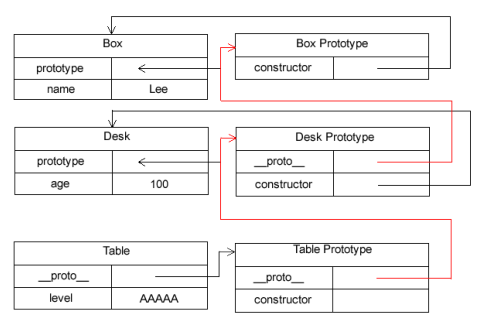继承是面向对象中一个比较核心的概念。其他正统面向对象语言都会用两种方式实现继承:一个是接口实现,一个是继承。而 ECMAScript 只支持继承,不支持接口实现,而实现
继承的方式依靠原型链完成。
function Box() { //Box 构造
this.name = 'Lee';
}
function Desk() { //Desk 构造
this.age = 100;
}
Desk.prototype = new Box(); //Desc 继承了 Box,通过原型,形成链条
var desk = new Desk();
alert(desk.age);
alert(desk.name); //得到被继承的属性
function Table() { //Table 构造
this.level = 'AAAAA';
}
Table.prototype = new Desk(); //继续原型链继承
var table = new Table();
alert(table.name); //继承了 Box 和 Desk
原型链继承流程图

如果要实例化 table,那么 Desk 实例中有 age=100,原型中增加相同的属性 age=200,
最后结果是多少呢?
Desk.prototype.age = 200; //实例和原型中均包含 age
PS:以上原型链继承还缺少一环,那就是 Obejct,所有的构造函数都继承自 Obejct。而继承 Object 是自动完成的,并不需要程序员手动继承。
经过继承后的实例,他们的从属关系会怎样呢?
alert(table instanceof Object); //true
alert(desk instanceof Table); //false,desk 是 table 的超类
alert(table instanceof Desk); //true
alert(table instanceof Box); //true
在 JavaScript 里,被继承的函数称为超类型(父类,基类也行,其他语言叫法),继承的函数称为子类型(子类,派生类)。继承也有之前问题,比如字面量重写原型会中断关系,使
用引用类型的原型,并且子类型还无法给超类型传递参数。为了解决引用共享和超类型无法传参的问题,我们采用一种叫借用构造函数的技术,或者成为对象冒充(伪造对象、经典继承)的技术来解决这两种问题。
function Box(age) {
this.name = ['Lee', 'Jack', 'Hello']
this.age = age;
}
function Desk(age) {
Box.call(this, age); //对象冒充,给超类型传参
}
var desk = new Desk(200);
alert(desk.age);
alert(desk.name);
desk.name.push('AAA'); //添加的新数据,只给 desk
alert(desk.name);
借用构造函数虽然解决了刚才两种问题,但没有原型,复用则无从谈起。所以,我们需要 原型链+借用构造函数的模式,这种模式成为 组合继承。
function Box(age) {
this.name = ['Lee', 'Jack', 'Hello']
this.age = age;
}
Box.prototype.run = function () {
return this.name + this.age;
};
function Desk(age) {
Box.call(this, age); //对象冒充
}
Desk.prototype = new Box(); //原型链继承
var desk = new Desk(100);
alert(desk.run());
还有一种继承模式叫做: 原型式继承;这种继承借助原型并基于已有的对象创建新对象 ,同时还不必因此创建自定义类型。
function obj(o) { //传递一个字面量函数
function F() {} //创建一个构造函数
F.prototype = o; //把字面量函数赋值给构造函数的原型
return new F(); //最终返回出实例化的构造函数
}
var box = { //字面量对象
name : 'Lee',
arr : ['哥哥','妹妹','姐姐']
};
var box1 = obj(box); //传递
alert(box1.name);
box1.name = 'Jack';
alert(box1.name);
alert(box1.arr);
box1.arr.push('父母');
alert(box1.arr);
var box2 = obj(box); //传递
alert(box2.name);
alert(box2.arr); //引用类型共享了
寄生式继承把原型式+工厂模式结合而来,目的是为了封装创建对象的过程。
function create(o) { //封装创建过程
var f= obj(o);
f.run = function () {
return this.arr; //同样,会共享引用
};
return f;
}
组合式继承是 JavaScript 最常用的继承模式;但,组合式继承也有一点小问题,就是超类型在使用过程中会被调用两次:一次是创建子类型的时候,另一次是在子类型构造函数的
内部。
function Box(name) {
this.name = name;
this.arr = ['哥哥','妹妹','父母'];
}
Box.prototype.run = function () {
return this.name;
};
function Desk(name, age) {
Box.call(this, name); //第二次调用 Box
this.age = age;
}
Desk.prototype = new Box(); //第一次调用 Box
以上代码是之前的组合继承,那么 寄生组合继承,解决了两次调用的问题。
function obj(o) {
function F() {}
F.prototype = o;
return new F();
}
function create(box, desk) {
var f = obj(box.prototype);
f.constructor = desk;
desk.prototype = f;
}
function Box(name) {
this.name = name;
this.arr = ['哥哥','妹妹','父母'];
}
Box.prototype.run = function () {
return this.name;
};
function Desk(name, age) {
Box.call(this, name);
this.age = age;
}
inPrototype(Box, Desk); //通过这里实现继承
var desk = new Desk('Lee',100);
desk.arr.push('姐姐');
alert(desk.arr);
alert(desk.run()); //只共享了方法
var desk2 = new Desk('Jack', 200);
alert(desk2.arr); //引用问题解决